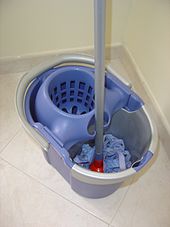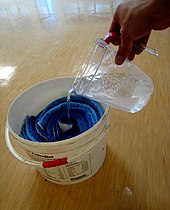Mop
The dry mop can in many instances replace a broom and has the ability to hold a limited amount of dust, sand, and debris within itself.
The wet mop is swept over the surface to dissolve and absorb fat, mud, and dried-on liquid contaminations.
Pre-moistening can be done with a special washing machine, or by hand by simply folding and packing the mops tight in a container and pouring the measured amount of water over them.
Sponge mop heads are constructed with a cellulosic, rubber, or plastic foam block, usually attached by crimping a metal clip on one side.
Sometimes, the foam mop head may be covered by a cloth or mesh sheet, to improve its resistance to wear from heavy scrubbing.
The sponge is then attached to a handle mechanism which can compress the mop head, by means of rollers or a pivoted flat perforated blade.
For heavy-duty or professional use, the mechanism is usually made of a corrosion-resistant metal such as stainless steel, and the mop head is often rubber or premium plastic foam.
For clean room environments, a stainless steel handle and mechanism are preferred, along with a mop head made of a foam which has been formulated to minimize shedding of small particles.




